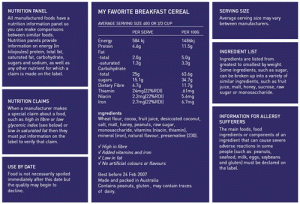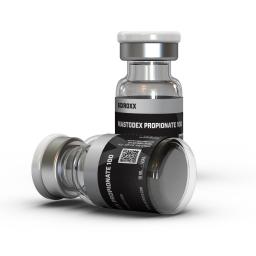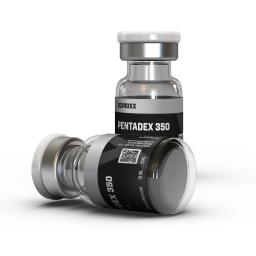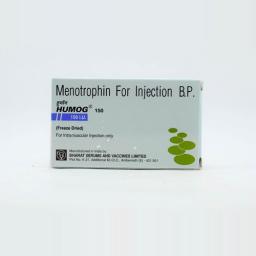What Does it Mean?
By dietician Cate Lombard
Are you surprised by the following?
Without reading the small print do you know what you’re getting when you buy your weekly groceries? |
|||
| Protein | 3.6g | 12.0g (12%) | |
| Fat | – Total | 0.4g | 1.3g (1.3%) |
| – Saturated | 0.1g | 0.3g (0.3%) | |
| Carbohydrate | – total | 20g | 67g |
| -sugars | 0.8g | 2.8g (2.8%) | |
| Dietry Fibre | 3.3g | 11.0g (11%) | |
| Sodium | 84mg | 280mg | |
| Potassium | 102mg | 340mg | |
| Thiamin | 0.55mg (50%RDI)* | 1.83mg | |
- Apple and strawberry fruit puree – with only 1% strawberry
- Lemon crumbed fish – without any lemon
- Bacon and onion sauce – with no bacon
Are you a label or a non label reader?
When it comes to the weekly shopping do you spend hours in the supermarket reading labels and choosing products or do you just throw the products in the trolley and get out as fast as you can?
A food label will tell you a lot of information if you know what you are looking for. Here we will try to explain labels, what they mean, how to choose the best products for your health and how to compare products.
Example information
How to choose a healthy product
Whilst it is preferable to eat fresh whole foods where possible, there are times we need to use manufactured foods to supplement our diet. For a healthy diet it is important to choose foods that assist in maintaining the correct balance of nutrients.
Because there are hundreds of thousands of manufactured products containing a huge range of ingredients it is impossible to advise on exactly what to look for on a label for each food. Here are some general guidelines related to important nutrients that might be helpful.
When looking at labels don’t just look at the kilojoules and the fat content. Compare the fibre, sugar and salt or sodium content.
| SUGAR | > | 10g sugar per 100g is a lot, 2g sugar per 100g is a little |
| FAT | > | 20g of fat per 100g is a lot, 3g of fat per 100g is a little |
| SALT | > | 500mg sodium per 100g is a lot, 100mg per 100g is a little |
| FIBRE | > | 10g fibre per 100g is a lot, 2g per 100g is a little |
A lot of foods make claims on their labels about benefits to health. Often these claims are promoted with a tick. However, the only strictly tested labelling program available in Australia is the National Heart Foundation Tick Program. Foods with the National Heart Foundation red tick logo must meet strict nutrient standards and be tested before they carry the tick. There may be similar products that are just as healthy as the Tick product, so check and compare the labels.
HINT Compare the nutrition value of similar products using the per 100g information. Add up your individual intake using the serving size information, but check the size of your serving first.
Fibre
Fibre is the indigestible part of plants. Choose foods high in fibre, preferably wholegrain. This is particularly important for bread and breakfast cereal, as these can provide a large proportion of our fibre needs for the day. The ingredient list will contain words such as wholegrain, wheat or wholemeal flour, whole oats or bran.
| Hi Bran Cereal | Per serve | per 100g |
| Dietary Fibre | 7.3g | 18.3g |
| Wholemeal Bread | Per slice | per 100g |
| Dietary Fibre | 3.5g | 6.0g |
HINT The average intake of fibre in Australian women is approximately 21g per day. We should aim for an intake of 30g per day.
Fat
Not all fats are bad. We do need to keep the total amount of fat in our diet reasonably low, but the trick is to make the fat we do eat come from oils such as nuts, seeds, fish or avocado and to avoid saturated fat from meat, chicken and dairy foods and even palm oil or vegetable shortening.
Polyunsaturated fats help reduce the risk of heart disease. They come in two forms: omega 3 fats found in fish and omega 6 fats are the more common type found in nuts, soy bean, sunflower and safflower oils and margarines. Generally we get plenty of omega 6 fats but not enough omega 3 fats in the Australian diet.
The label will help you identify foods that have a lot of saturated fat. The example below tells us that most of the fat in this product is saturated and therefore should be avoided.
| Frozen Oven Fry Chips | |
| Per serve | |
| Total fat | 25g |
| -saturated fat | 20g |
| Ingredients: potatoes, tallow, vegetable shortening, salt, preservative | |
With recent interest in omega 3 fatty acids and their importance for health, some manufacturers now point this out on the label. For example canned tuna is naturally a good source of these fats. The manufacturer might include this on the label, but it does not mean they have added any additional omega 3 fatty acids.
HINT If you are a moderately active women an intake of 50 -60 grams per day would be considered a moderate fat intake. If you are wanting to reduce your weight or reduce fat intake for health reasons aim for 40g per day.
HINT 1 teaspoon fat is approximately 5g so if a label says 25g fat that is equal to about 5 teaspoons per serve .
HINT Fat can also be disguised on labels as animal fat, vegetable oil, coconut, copha, cream, di or monoglycerides, lard, mayonnaise, milk solids, palm oil, shortening or tallow.
Sugar
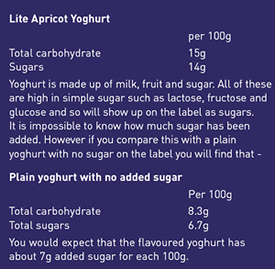 Sugar on the nutrition panel comes under two headings: total carbohydrate and added sugar or just sugar. The total carbohydrate includes the sugar or starch that occurs naturally in a food such as milk, flour, grains such as rice, fruit, vegetables such as potato, as well as any added sugar.
Sugar on the nutrition panel comes under two headings: total carbohydrate and added sugar or just sugar. The total carbohydrate includes the sugar or starch that occurs naturally in a food such as milk, flour, grains such as rice, fruit, vegetables such as potato, as well as any added sugar.
The total sugars tell you how much sugar is in the product but still includes the natural sugars from fruit, dried fruit and milk. This is why some foods with dried fruit in them seem to have a high sugar content.
Of course manufacturers can add these in place of sugar to ‘naturally ‘ sweeten foods. Natural or added sugar have the same kilojoule value.
HINT 5 grams sugar is equal to 1 teaspoon. Check the breakfast cereal in your cupboard now and calculate how much sugar you or your children are having for breakfast each day. If the cereal says 25g sugars per serve then that is equal to 5 teaspoons of sugar for breakfast.
HINT Sugar can also feature on labels as malt, malt extract, maltose, maltodextrines, dextrose, glucose, glucose syrup, raw sugar, fruit juice, fructose or apple juice. HINT Low fat products often labelled light, lite, or fat free are often high in sugar. They do contain little fat but have so much added sugar that the final kilojoule content can be just as high as a regular product.
Explaining the terms
Low GI means Low Glycemic Index
This is a rating of the effect of the food on blood sugar levels and is not necessarily related to the sugar content or the total carbohydrate. Foods considered to be low GI will raise blood sugar slowly and may satisfy our hunger for a longer period. Low GI foods can help people with diabetes control their condition. Carbohydrate occurs naturally in food as starch or sugar and provides energy.
Carbohydrate is important to the normal functioning of the body. Foods are now appearing with labels stating they are low carbohydrate. This is in response to a number of ‘Fad Diets’ claiming the benefits of low carb and high protein diet over a traditional low kilojoule balanced diet. There is little evidence that reducing carbohydrates has any advantage over other eating patterns.
97% fat free means the food contains 3 percent fat, or 3 grams in each 100 grams.
Cholesterol free can be confusing and these foods may still be high in fat.
Light or lite can mean a number of things: light taste, light salted, less fat: check the label carefully.
Cooked in vegetable oil. Palm oil is often used to fry snack foods. This is still high in saturated fat. It would be better to choose foods with polyunsaturated, canola or olive oil.
Reduced salt 25% less salt than their counterparts. No artificial colours or flavours can be misleading as some foods such as bread and breakfast food are not permitted to contain these anyway. They can still contain natural colour such as caramel, or beta carotene to give a brown or golden colour and flavour such as cocoa. These foods may still contain preservatives.
Recommended Daily Intake (RDI ) for nutrients such as vitamins and minerals. Vitamins and minerals are permitted to be added to foods. However the Australian New Zealand Food Authority ( ANZFA) Standards Code only allows added vitamins and minerals where there is a demonstrated benefit to health and where there will be no harm caused. If a manufacturer wishes to make a claim regarding the vitamin or mineral content, the food needs to provide at least 10% of the recommended daily intake (RDI) for that vitamin or mineral. .The nutrition panel will also include a reference to that nutrient and provide information about the proportion of the RDI for that vitamin or mineral.
Summary
- Eat whole fresh foods where possible.
- Compare the labels of manufactured foods. Compare the nutrition panels of similar products using the per 100g information.
- Don’t just look at the fat and kilojoule content. Compare the fibre, sugar and salt.
- Don’t be fooled when some breakfast cereals are advertised as being healthy: check and compare the labels and ingredient list.
- The ingredient list will tell you what foods are providing the highest proportion of sugar and fat. Don’t forget some fats and sugars can be disguised with a number of names.
- Choose foods low in saturated fat.
Note: This article is an archive. Whilst the Women’s Health Secrets has made every effort to ensure this information was accurate at the time of publication, the article content has not been updated since the date listed below.
Top Steroid Products Sales
Masteron 500 (5ml)
|
Pentadex 300
|
HMG Gen-Shi 75 IU
|
